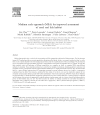Habitat characteristics play a critical role in structuring reef fish communities subjected to fishing pressure. The line intercept transect (LIT) method provides an accurate quantitative description of the habitat, but in a very narrow corridor less than 1 m wide. Such a scale is poorly adapted to the wide-ranging species that account for a significant part of these assemblages. We developed an easy-to-use medium scale approach (MSA), based on a semi-quantitative description of 20 quadrats of 25 m2 (500 m2 in total). We then simulated virtual reef landscapes of different complexities in a computer, on which we computed MSA using different methods of calculation. These simulations allowed us to select the best method of calculation, obtaining quantitative estimates with acceptable accuracy (comparison with the original simulated landscapes: R2 ranging from 0.986 to 0.997); they also showed that MSA is a more efficient estimator than LIT, generating percentage coverage estimates that are less variable. A mensurative experiment based on thirty 50-m transects, conducted by three teams of two divers, was used to empirically compare the two estimators and assess their ability to predict fish–habitat relationships. Three-factor multivariate ANOVAs (Teams, Reef, Methods) revealed again that LIT produced habitat composition estimates that were more variable than MSA. Canonical analyses conducted on fish biomass data successively aggregated by mobility patterns, trophic groups, and size classes, showed the higher predictive power of MSA habitat data over LIT. The MSA enriches the toolbox of methods available for reef habitat description at intermediate scale (< 1000 m2), between the scale where LIT is appropriate (< 100 m2) and the landscape approach (> 1000 m2).


 English
English
